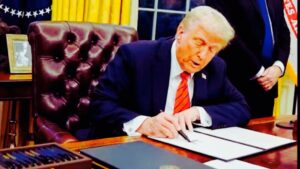Trump Signals Tariff Reduction: What It Means for the Economy and You
In a surprising shift that could reshape global trade dynamics, former President Donald Trump has recently signaled a willingness to reduce tariffs, sparking debates across economic, political, and business circles. While his administration was known for tough trade policies—especially the imposition of tariffs on Chinese goods—this new stance suggests a potential pivot that could have widespread implications.
But what does a tariff reduction really mean? How does it affect businesses, consumers, and the global market? And why now?
Let’s break it down.
 🔍 What Are Tariffs, and Why Do They Matter?
🔍 What Are Tariffs, and Why Do They Matter?
Before we dive into the recent developments, a quick refresher:
Tariffs are taxes imposed on imported goods. The goal is often to:
-
Protect domestic industries from foreign competition
-
Generate revenue for the government
-
Leverage trade negotiations
However, tariffs also raise the cost of imported products, which can lead to higher prices for consumers and increased costs for businesses that rely on international supply chains.
📣 Trump’s New Message: A Softer Trade Tone?
According to recent interviews and campaign trail remarks, Trump has hinted that reducing certain tariffs could be on the table if it benefits American economic interests. While he hasn’t provided a detailed tariff reduction plan, this shift in rhetoric suggests a more flexible approach compared to his earlier hardline stance.
This is a notable departure from the “America First” trade war strategy that defined much of his presidency, particularly the tariff hikes on Chinese imports in 2018 and 2019, which sparked global trade tensions and retaliatory tariffs.
Keywords to Watch:
-
Tariff reduction 2025
-
Trump trade policy update
-
Trump on China tariffs
-
Economic impact of tariff cuts
 🌐 Global Reactions and Market Implications
🌐 Global Reactions and Market Implications
The international response to Trump’s tariff remarks has been mixed. Some business leaders and market analysts see this as a positive sign that could ease global supply chain pressures and reduce inflationary strain.
Stock markets responded favorably, especially in industries heavily reliant on imports—such as automotive, electronics, and retail. The idea of cheaper goods entering the U.S. market also buoyed consumer sentiment in the short term.
Meanwhile, trade partners like China, the EU, and Canada are watching closely, wondering if this opens the door to more cooperative trade talks or if it’s a strategic move aimed at strengthening Trump’s economic platform ahead of the 2024 election season.
💼 What Does This Mean for Businesses?
For small businesses and large corporations alike, a tariff reduction could translate into:
-
Lower costs on imported materials and products
-
Improved supply chain efficiency
-
More competitive pricing for consumers
However, domestic manufacturers that benefited from tariff protections may face renewed pressure from cheaper foreign alternatives. It’s a classic trade-off between protecting local jobs and promoting consumer savings.
🛒 And What About Everyday Consumers?
Here’s the bottom line: if tariffs are reduced, prices on imported goods could drop.
That could mean:
-
Cheaper electronics, clothing, and household items
-
More options for consumers
-
Relief on inflationary pressure
But keep in mind, tariff changes don’t happen overnight. They typically involve legislative action, diplomatic negotiations, and economic strategy. Still, the signal alone is already impacting public perception and financial forecasts.
🧠 Why Now? Timing Is Everything
Trump’s comments come at a time when:
-
Global inflation remains a concern
-
Supply chains are still stabilizing post-pandemic
-
Economic anxiety is rising among American voters
With the 2024 election looming, the suggestion of tariff relief may be a strategic move to appeal to both consumers and the business community, positioning Trump as a leader focused on economic pragmatism.
📝 Final Thoughts: A Wait-and-See Moment
While it’s still unclear whether Trump will follow through with actual tariff cuts, the mere signal of reduction is enough to stir markets, influence trade policy discussions, and ignite public interest.
For now, we’re in a wait-and-see moment. But one thing is certain—tariffs and trade will remain a hot topic in the months ahead, especially as political campaigns ramp up and global economies continue to adjust.
